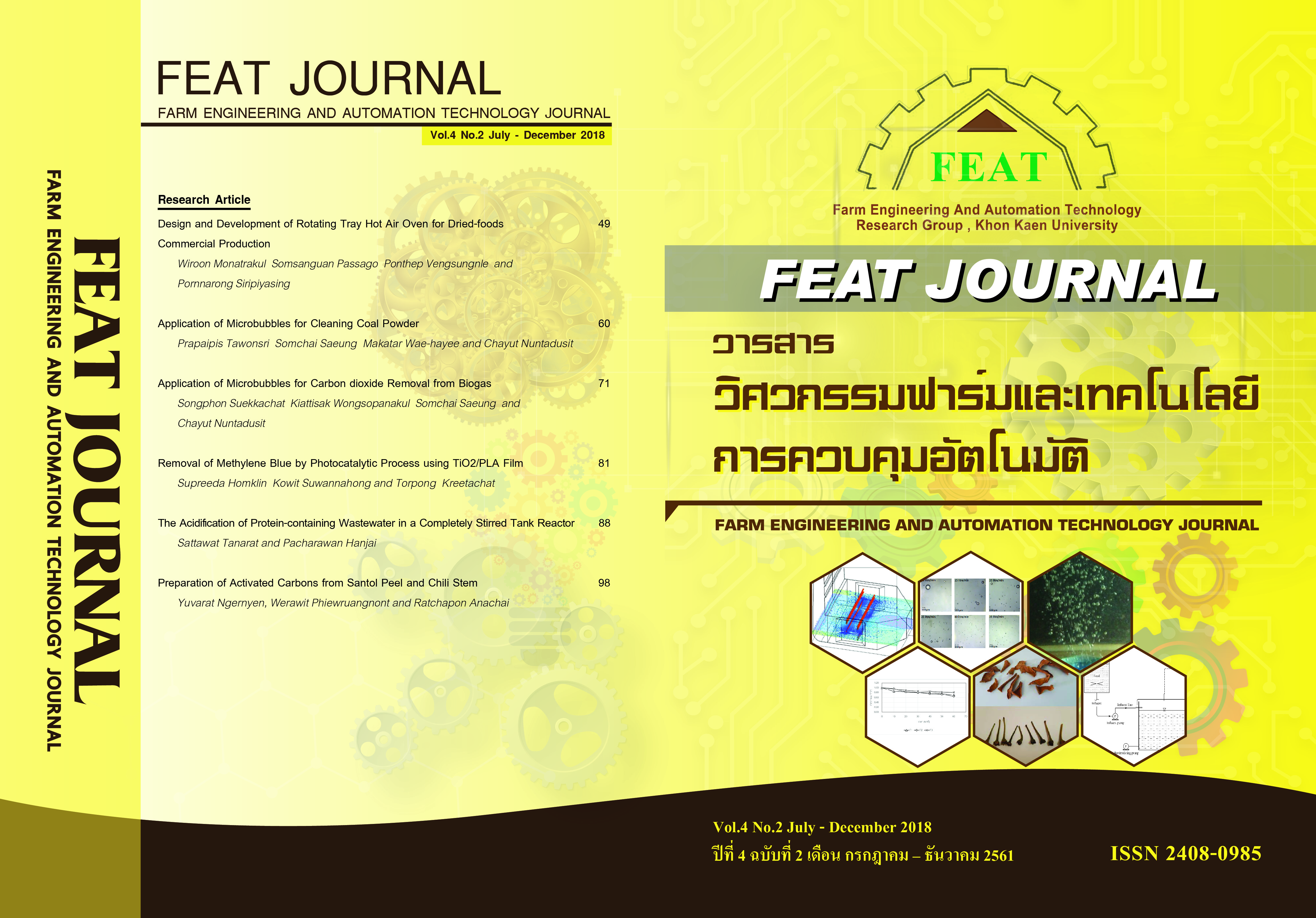การเตรียมถ่านกัมมันต์จากเปลือกกระท้อนและก้านพริก
Main Article Content
บทคัดย่อ
งานวิจัยนี้ศึกษาการเตรียมถ่านกัมมันต์จากเปลือกกระท้อนและก้านพริกโดยการกระตุ้นทางเคมีด้วยซิงค์คลอไรด์ กรดฟอสฟอริก เฟอริกคลอไรด์ และโพแทสเซียมไฮดรอกไซด์ และการกระตุ้นทางกายภาพด้วยแก๊สคาร์บอนไดออกไซด์ โดยทำการวิเคราะห์พื้นที่ผิวและสมบัติรูพรุนของถ่านกัมมันต์ที่เตรียมได้ ผลการศึกษาพบว่า สำหรับเปลือกกระท้อน กรดฟอสฟอริกสามารถเตรียมถ่านกัมมันต์ที่มีพื้นที่ผิวสูงที่สุด โดยมีพื้นที่ผิว 577 m2/g มีปริมาตรรูพรุนรวม 0.447 cm3/g และมีขนาดรูพรุนเฉลี่ย 3.10 nm โดยมีรูพรุนขนาดเล็ก 58.2% ส่วนการกระตุ้นก้านพริกด้วยซิงค์คลอไรด์ได้ถ่านกัมมันต์ที่มีพื้นที่ผิวสูงที่สุด คือ 400 m2/g โดยมีปริมาตรรูพรุนรวม 0.270 cm3/g และมีขนาดรูพรุนเฉลี่ย 2.70 nm โดยเป็นถ่านกัมมันต์ที่มีรูพรุนขนาดเล็กเป็นส่วนใหญ่ถึง 70% ซึ่งเมื่อทำการเปรียบเทียบพื้นที่ผิวของถ่านกัมมันต์ที่เตรียมได้กับงานวิจัยอื่น ๆ พบว่า ถ่านกัมมันต์จากเปลือกกระท้อนและก้านพริกมีพื้นที่ผิวสูงกว่าถ่านกัมมันต์ที่เตรียมได้จากวัตถุดิบชนิดต่าง ๆ หลากหลายชนิด ดังนั้น เปลือกกระท้อนและก้านพริกซึ่งเป็นวัสดุเหลือทิ้งจากการเกษตร จึงมีศักยภาพที่จะใช้เป็นวัตถุดิบในการนำมาผลิตเป็นถ่านกัมมันต์
Article Details
วารสารวิศวกรรมฟาร์มและเทคโนโลยีควบคุมอัตโนมัติ (FEAT Journal) มีกําหนดออกเป็นราย 6 เดือน คือ มกราคม - มิถุนายน และกรกฎาคม - ธันวาคม ของทุกปี จัดพิมพ์โดยกลุ่มวิจัยวิศวกรรมฟาร์มและเทคโนโลยีควบคุมอัตโนมัติ คณะวิศวกรรมศาสตร์มหาวิทยาลัยขอนแก่น เพื่อเป็นการส่งเสริมและเผยแพร่ความรู้ ผลงานทางวิชาการ งานวิจัยทางด้านวิศวกรรมศาสตร์และเทคโนโลยีพร้อมทั้งยังจัดส่ง เผยแพร่ตามสถาบันการศึกษาต่างๆ ในประเทศด้วย บทความที่ตีพิมพ์ลงในวารสาร FEAT ทุกบทความนั้นจะต้องผ่านความเห็นชอบจากผู้ทรงคุณวุฒิในสาขาที่เกี่ยวข้องและสงวนสิทธิ์ ตาม พ.ร.บ. ลิขสิทธิ์ พ.ศ. 2535
เอกสารอ้างอิง
[2] Chang CF, Chang CY, Tsai WT. Effects of burn-off and activation temperature on preparation of activated carbon from corn cob agrowaste by CO2 and steam. Journal of Colloid and Interface Science 2000; 232: 45-9.
[3] Darmstadt H, Garcia-Perez M, Chaala A, Cao NZ, Roy C. Co-pyrolysis under vacuum of sugar cane bagasse and petroleum residue properties of the char and activated char products. Carbon 2001; 39: 815-25.
[4] Lua A, Guo J. Activated carbon prepared from oil palm stone by one-step CO2 activation for gaseous pollutant removal. Carbon 2000; 38: 1089-97.
[5] Oh GH, Park CR. Preparation and characteristics of rice-straw-based porous carbons with high adsorption capacity. Fuel 2002; 81: 327-36.
[6] Nethaji S, Sivasamy A. Adsorptive removal of an acid dye by lignocellulosic waste biomass activated carbon: equilibrium and kinetic studies. Chemosphere 2011; 82: 1367-72.
[7] Ghaedi M, Mazaheri H, Khodadoust S, Hajati S, Purkait MK. Application of central composite design for simultaneous removal of methylene blue and Pb2+ ions by walnut wood activated carbon. Spectrochimica Acta Part A: Molecular and Biomolecular Spectroscopy 2015; 135: 479-90.
[8] Hajati S, Ghaedi M, Yaghoubi S. Local, cheap and nontoxic activated carbon as efficient adsorbent for the simultaneous removal of cadmium ions and malachite green: optimization by surface response methodology. Journal of Industrial and Engineering Chemistry 2015; 21: 760-67.
[9] AL-Othman ZA, Ali R, Naushad Mu. Hexavalent chromium removal from aqueous medium by activated carbon prepared from peanut shell: Adsorption kinetics, equilibrium and thermodynamic studies. Chemical Engineering Journal 2012; 184: 238-47.
[10] Al-Rahbi AS, Williams PT. Production of activated carbons from waste tyres for low temperature NOx control. Waste Management 2016; 49: 188-95.
[11] Kabulov AT, Nechipurenko SV, Sailaukhanuly Y, Mastai Y, Yefremov SA, Nauryzbayev MK. Preparation and characterization of activated carbons prepared from wood waste and their application for gas separation. Int. J. Chem. Sci. 2015; 13(2): 747-58.
[12] Silva TL, Ronix A, Pezoti O, Souza LS, Leandro PKT, Bedin KC, et al. Mesoporous activated carbon from industrial laundry sewage sludge: Adsorption studies of reactive dye Remazol Brilliant Blue R. Chemical Engineering Journal 2016; 303: 467-76.
[13] Boualem T, Debab A, Yuso AM, Izquierdo MT. Activated carbons obtained from sewage sludge by chemical activation: Gas-phase environmental applications. Journal of Environmental Management 2014; 40: 145-51.
[14] Lacerda VS, Lopez-Sotelo JB, Correa-Guimaraes A, Hernandez-Navarro S, Sanchez-Bascones M, Navas-Gracia LM, et al. Rhodamine B removal with activated carbons obtained from lignocellulosic waste. J. Env. Manage. 2015; 155: 67-76.
[15] Shamsuddin MS, Yusoff NRN, Sulaiman MA. Synthesis and characterization of activated carbon produced from kenaf core fiber using H3PO4 activation. Procedia Chemistry 2016; 19: 558-65.
[16] Rai MK, Shahi G, Meena R, Chakraborty S, Singth RS, Rai BN. Removal of hexavalent chromium Cr (VI) using activated carbon prepared from mango kernel activated with H3PO4. Resource-Efficient Technology 2016; 2: S63-S70.
[17] Huang Y, Li S, Lin H, Chen J. Fabrication and characterization of mesoporous activated carbon from Lemna minor using one-step H3PO4 activation for Pb(II) removal. Applied Surface Science 2014; 317: 422-431.


